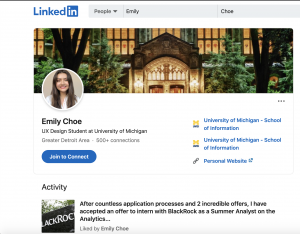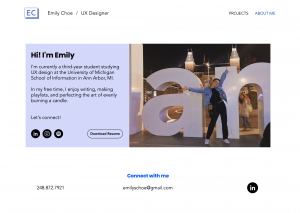Emily Choe
Introduction
My data identity doesn’t capture a holistic view of who I am; most of the data that can be found online about me reflects a younger version of myself, and the more current data about me only reflects the information that I’ve curated for job recruiters to see. The first three results when I google search “Emily Choe” are my LinkedIn, my Her Campus profile, and my Facebook. Two of these I haven’t touched in years; my Her Campus profile consists of cringey articles I wrote during my first two years of undergrad, and my Facebook account is so out of date that my profile picture is a photo of me with an ex-boyfriend from two years ago. Needless to say, the results from a quick google search don’t reflect the most accurate or representative picture of who I am— especially not my twenty-two-year-old self.
Recent content
The most relevant or recent data about me is on my LinkedIn; it shows where I work and where I go to school. From this, you can infer a lot; I’m interested in UX Research, UX Design, and HCI; I know how to code in Python and HTML/CSS; I’m on the e-board of Girls Who Code; I was a ballet student at the University of Utah before transferring to the University of Michigan to study UX Design; I studied abroad; from my volunteer experience, you could guess that advocacy for survivors of sexual assault is something that I care about. Despite all of this information, the polished presentation of my LinkedIn doesn’t tell you everything. For instance, I’m actually pretty terrible at Spanish despite living in a Spanish-speaking country for eight months and being three credits short of a Spanish minor. (Which I’m not sure I’ll finish, because like I said, I’m terrible at Spanish.)
My Portfolio Website
On my LinkedIn is a link to my portfolio website. This is pretty similar to my LinkedIn, considering I made it for recruiters to see my past work when I was applying to jobs. Here, you can read my elevator pitch about why I love UX research and design, as well as see some of the projects I’ve gotten to work on. This provides more context to my LinkedIn, such as exactly what I did in my current research role. Half of the projects on my portfolio I don’t even like, and I never talk about them during portfolio reviews. They’re mostly there to bolster space and show that I’ve worked on more than two projects, even if I only think that two of them are actually good. Even on the website that I built and designed myself, there are parts of it I wish I didn’t have to share.
My “About Me” page of my portfolio website can link you to my Spotify, where you’ll find that I listen to a lot of Taylor Swift. (Don’t judge me.) What’s interesting about my Spotify data is that I’ve kept the same account since 2013; all the playlists from different periods of my life have become time-capsules of what music resonated with me at the time. As far as my music interests and what podcasts I listen to, Spotify is pretty accurate. This makes sense; I interact with Spotify every day for most of the day. I’m making new playlists all the time, whereas I can’t remember the last time I posted on Facebook.

